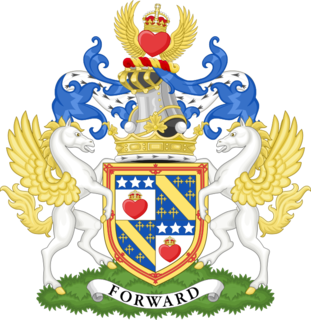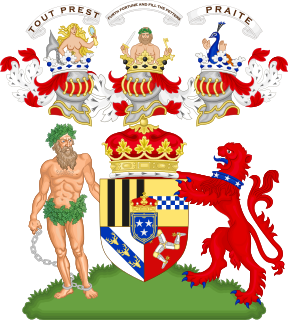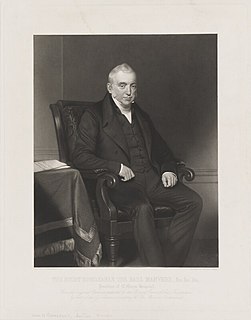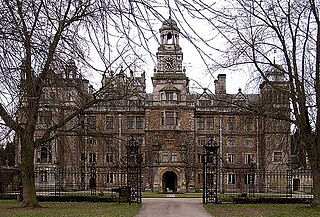
Marquess of Queensberry is a title in the Peerage of Scotland. The title has been held since its creation in 1682 by a member of the Douglas family. The Marquesses also held the title of Duke of Queensberry from 1684 to 1810, when it was inherited by the Duke of Buccleuch.
Duke of Buckingham held with Duke of Chandos, referring to Buckingham, is a title that has been created several times in the peerages of England, Great Britain, and the United Kingdom. There have also been earls and marquesses of Buckingham.

Duke of Atholl, named for Atholl in Scotland, is a title in the Peerage of Scotland held by the head of Clan Murray. It was created by Queen Anne in 1703 for John Murray, 2nd Marquess of Atholl, with a special remainder to the heir male of his father, the 1st Marquess.

The title Duke of Queensberry was created in the Peerage of Scotland on 3 February 1684 along with the subsidiary title Marquess of Dumfriesshire for the 1st Marquess of Queensberry. The Dukedom was held along with the Marquessate of Queensberry until the death of the 4th Duke in 1810, when the Marquessate was inherited by Sir Charles Douglas of Kelhead, 5th Baronet, while the Dukedom was inherited by the 3rd Duke of Buccleuch. Since then the title of Duke of Queensberry has been held by the Dukes of Buccleuch.

Viscount Bridport is a title that has been created twice, once in the Peerage of Great Britain and once in the Peerage of the United Kingdom. The first creation became extinct in 1814, while the second creation is still extant.

Duke of Kingston-upon-Hull was a title in the Peerage of Great Britain, with the title Earl of Kingston-upon-Hull being a title in the Peerage of England. The Earldom was created on 25 July 1628 for Robert Pierrepont, 1st Viscount Newark. The Dukedom was created on 10 August 1715 for his great-grandson, Evelyn Pierrepont, 1st Marquess of Dorchester, who had succeeded as the fifth Earl of Kingston-upon-Hull in 1690. The Dukedom became extinct on the death of the second Duke in 1773. Unlike the city to which they refer, Kingston upon Hull, which is usually shortened to Hull, these titles are usually shortened to Duke of Kingston.. They should not be confused with the separate Irish Earldom of Kingston.

Earl Manvers was a title in the Peerage of the United Kingdom. It was created in 1806 for Charles Medows Pierrepont, 1st Viscount Newark. He had already been created Baron Pierrepont, of Holme Pierrepont in the County of Nottingham, and Viscount Newark, of Newark-on-Trent in the County of Nottingham, in 1796. Both these titles were in the Peerage of Great Britain. Born Charles Medows, he was the second son of Philip Medows, Deputy Ranger of Richmond Park, by Lady Frances Pierrepont, daughter of William Pierrepont, Earl of Kingston (1692–1713), eldest son and heir apparent of Evelyn Pierrepont, 1st Duke of Kingston-upon-Hull. The name of the earldom derives from the Manvers family, from a marriage to an heiress of which family the family seat of Holme Pierrepont had passed into the Pierrepont family in the 13th century.

Robert Pierrepont, 1st Earl of Kingston-upon-Hull was an English nobleman who joined the Royalist side in the English Civil War after some delay and became lieutenant-general of the counties of Lincoln, Rutland, Huntingdon, Cambridge and Norfolk. He was killed in a friendly fire incident after being captured by Parliamentary forces.

Henry Pierrepont, 1st Marquess of Dorchester, PC, FRS, FRCP was an English peer. He was the son of Robert Pierrepont, 1st Earl of Kingston-upon-Hull, and his wife, the former Gertrude Talbot, daughter of George Talbot and Elizabeth Reyner, and cousin of the Earl of Shrewsbury.
The title Earl of Holderness also known as Holdernesse existed in the late 11th and early 12th centuries as a feudal lordship and was officially created three times in the Peerage of England namely in 1621, in 1644 as a subsidiary title to that of the then-Duke of Cumberland and in 1682. The official creations lasted 5, 38 and 96 years respectively.

Evelyn Pierrepont, 2nd Duke of Kingston-upon-Hull, KG was an English nobleman and landowner, a member of the House of Lords. He was the only son of William Pierrepont, Earl of Kingston-upon-Hull (1692–1713) and his wife, Rachel Bayntun (1695–1722).

Baron Pierrepont is a title that has been created four times in British history. The first creation came in the Peerage of England on 29 June 1627 when Sir Robert Pierrepont was created Baron Pierrepont, also being created Viscount Newark at the same time. He was further created Earl of Kingston-upon-Hull in 1628. The fifth Earl was created Duke of Kingston-upon-Hull in 1715 in the Peerage of Great Britain, with the Dukedom becoming extinct on the death of the second Duke in 1773.

Charles William Sydney Pierrepont, 4th Earl Manvers, VD, known as Viscount Newark from 1860 to 1900, was a British nobleman and Conservative Party politician.

Charles Herbert Pierrepont, 2nd Earl Manvers was an English nobleman and naval officer, the second son of Charles Pierrepont, 1st Earl Manvers.

Charles (Medows) Pierrepont, 1st Earl Manvers was a British naval officer and politician who sat in the House of Commons from 1778 to 1796 when he was raised to the peerage as Viscount Newark.

Thoresby Hall is a grade I listed 19th-century country house in Budby, Nottinghamshire, some 2 miles (4 km) north of Ollerton. It is one of four neighbouring country houses and estates in the Dukeries in north Nottinghamshire all occupied by dukes at one time during their history. The hall is constructed of rock-faced ashlar with ashlar dressings. It is built in four storeys with a square floor plan surrounding a central courtyard, nine bays wide and eight bays deep.
Nottinghamshire was a county constituency of the House of Commons of the Parliament of England then of the Parliament of Great Britain from 1707 to 1800 and of the Parliament of the United Kingdom from 1801 to 1832. It was represented by two Members of Parliament (MPs), traditionally known as Knights of the Shire.

Horatio Walpole, 1st Earl of Orford was a British Whig politician.

Holme Pierrepont Hall is a medieval Manor House in Holme Pierrepont near Nottingham. It is a Grade I listed building.
Gertrude Pierrepont, Countess of Kingston-upon-Hull, born Gertrude Talbot, was an English noblewoman and peeress, the wife of Robert Pierrepont, 1st Earl of Kingston-upon-Hull, and the daughter of the Honourable Henry Talbot, and his wife, the former Elizabeth Reyner.














